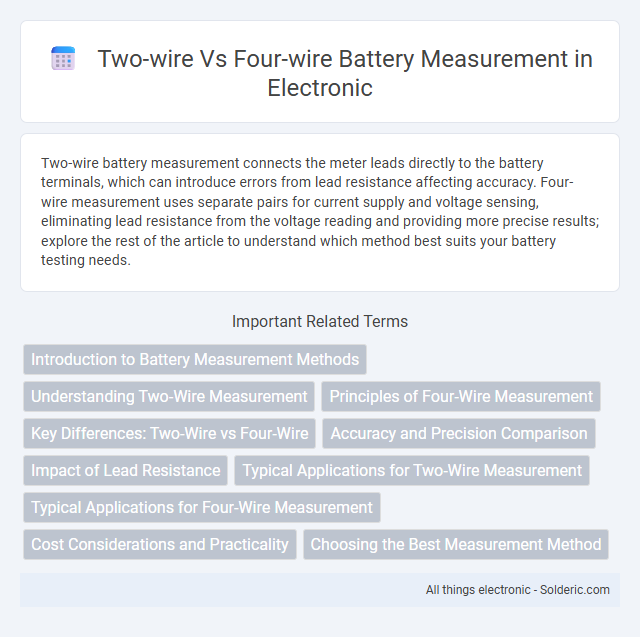Two-wire battery measurement connects the meter leads directly to the battery terminals, which can introduce errors from lead resistance affecting accuracy. Four-wire measurement uses separate pairs for current supply and voltage sensing, eliminating lead resistance from the voltage reading and providing more precise results; explore the rest of the article to understand which method best suits your battery testing needs.
Comparison Table
| Feature | Two-Wire Measurement | Four-Wire Measurement |
|---|---|---|
| Accuracy | Lower, affected by lead resistance | High, eliminates lead resistance error |
| Wiring Complexity | Simple, uses 2 wires | Complex, uses 4 wires |
| Use Case | Basic battery tests, low precision | Precise voltage and resistance measurement |
| Lead Resistance Impact | Significant impact on measurement | Negligible impact due to Kelvin sensing |
| Cost | Lower, fewer components | Higher, more complex setup |
| Measurement Speed | Faster due to simpler setup | Slower, due to additional wiring and connections |
Introduction to Battery Measurement Methods
Two-wire battery measurement uses a simple connection with one pair of leads for current supply and voltage sensing, which can introduce errors due to lead resistance. Four-wire measurement employs separate pairs for current and voltage, minimizing the impact of lead resistance and providing more accurate voltage readings, especially in low-resistance or high-precision applications. For your battery testing, choosing four-wire measurement improves accuracy in evaluating battery health and performance.
Understanding Two-Wire Measurement
Two-wire battery measurement involves connecting the test leads directly to the battery terminals, where the same pair of wires supplies current and measures voltage, leading to inaccuracies due to voltage drops across the lead resistance. This method is suitable for low-precision applications or batteries with high voltage output, but it can introduce significant errors in low-voltage or high-precision scenarios. Accurate voltage readings require minimizing the impact of lead resistance, which is inherently limited in two-wire setups compared to four-wire configurations.
Principles of Four-Wire Measurement
Four-wire measurement improves accuracy by using separate pairs of wires for current and voltage, eliminating the effect of lead resistance on voltage readings. This technique involves sourcing a known current through the outer wires while measuring the voltage drop across the battery with the inner wires, ensuring precise and reliable results. Your battery testing becomes more accurate and consistent, especially for low-resistance or low-voltage measurements.
Key Differences: Two-Wire vs Four-Wire
Two-wire battery measurement uses a single pair of leads for both current supply and voltage sensing, which introduces measurement errors due to lead resistance. Four-wire measurement employs separate pairs for current supply and voltage sensing, eliminating the effect of lead resistance and providing more accurate voltage readings. This distinction makes four-wire measurement the preferred method for precise battery testing and low-resistance measurements.
Accuracy and Precision Comparison
Four-wire battery measurement offers superior accuracy and precision by eliminating the voltage drops caused by lead and contact resistances inherent in two-wire configurations. Two-wire methods often produce measurement errors due to the combined resistance of the test leads, reducing reliability in low-resistance or low-voltage battery testing. Implementing a four-wire technique ensures that voltage is directly sensed at the battery terminals, providing precise voltage readings essential for high-fidelity battery performance analysis.
Impact of Lead Resistance
Lead resistance significantly affects the accuracy of two-wire battery measurements by adding error to the voltage reading, which can lead to an overestimation of the battery voltage. Four-wire measurement techniques eliminate the influence of lead resistance by using separate pairs of wires for current supply and voltage sensing, ensuring your readings reflect the true battery voltage. This distinction is crucial for applications demanding high-precision battery monitoring and management.
Typical Applications for Two-Wire Measurement
Two-wire battery measurement is commonly used in applications where simplicity and cost-effectiveness are prioritized, such as in consumer electronics and low-power devices. This method is typical for routine testing of small batteries like AA, AAA, and coin cells, where precise accuracy is less critical. It is ideal for quick voltage checks in portable gadgets and basic battery health monitoring.
Typical Applications for Four-Wire Measurement
Four-wire battery measurement is commonly used in high-precision applications such as laboratory testing, battery manufacturing quality control, and advanced battery management systems where accurate resistance and voltage readings are critical. This method eliminates the effect of lead and contact resistance, ensuring precise measurement in lithium-ion batteries and other high-capacity cells. If your project demands exact state-of-charge and health monitoring for rechargeable batteries, four-wire measurement provides unmatched accuracy.
Cost Considerations and Practicality
Two-wire battery measurement systems offer lower initial costs and simpler installation, making them practical for basic applications with less stringent accuracy requirements. Four-wire measurement systems reduce the impact of lead resistance, providing more precise voltage readings essential for critical battery monitoring, though they incur higher hardware costs and complexity. Choosing between the two depends on balancing budget constraints against the need for measurement accuracy in the specific battery management scenario.
Choosing the Best Measurement Method
Choosing the best battery measurement method depends on the accuracy needed and the application environment. Two-wire measurement is simpler and suitable for low-precision tasks but suffers from lead resistance errors, while four-wire measurement offers higher accuracy by eliminating lead resistance effects, critical for precise battery testing and monitoring. Your choice should align with the required measurement precision and circuit complexity.
Two-wire vs four-wire battery measurement Infographic

 solderic.com
solderic.com